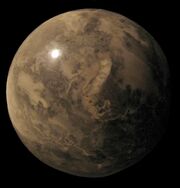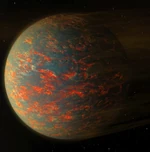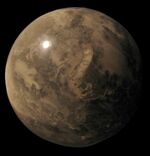
A carbon planet, a theoretical type of planet
This following article contains a list of planet types. Some of these planet types are totally theoretical and may not exist (but are nonetheless technically possible), while others on the list have been fully observed and proven to exist. The page is broken down between massive, giant planets, and smaller, terrestrial planets.
Giant planet types[]
These kinds of planets are usually very massive and very large, and are normally composed of gas such as hydrogen and helium, but may also be composed of ice.
| Planet type | Concept Image | Description |
|---|---|---|
| Brown dwarf | 
|
A brown dwarf is a type of substellar object, between 13 to 80 times that of Jupiter. This is a kind of "failed-star" that does not have enough mass to trigger hydrogen fusion reactions.
There are some planets known to orbit brown dwarfs. |
| Chthonian planet | 
|
A former gas giant planet that orbits so closely to its host star, it has had its atmosphere stripped away, leaving only its core. |
| Eccentric Jupiter | 
|
A gas giant similar in composition to Jupiter that has an eccentric orbit. |
| Gas giant | 
|
A giant planet which is primarily composed of hydrogen and helium. A majority of the extrasolar planets discovered so far have been gas giants. |
| Giant planet | 
|
Any type of massive, giant planet. These kinds of planets are primarily composed of gas, such as hydrogen and helium, or ice, like water, methane, ammonia, etc. Its also possible for a giant planet to be made of rock, which would make it a Mega-Earth. |
| Helium planet | 
|
A giant planet primarily composed of helium rather than hydrogen. |
| Hot Jupiter | 
|
A giant planet which has similar characteristics to the planet Jupiter, except that it orbits extremely closely to its host star, between 0.015 and 0.5 AU. They typically take days, or in some cases, mere hours, to orbit their host stars. |
| Hot Neptune | 
|
A giant planet which has a similar mass to the planet Neptune, except that it orbits closely to its host star - typically less than one AU. |
| Ice giant | 
|
A giant planet mainly composed of ices - such as water, methane, and ammonia, as opposed to gas. |
| Mini-Neptune | 
|
Also called a "gas dwarf", this type of planet is similar in composition to a gas giant, but is less massive than Uranus or Neptune. They have up to 10 or more Earth masses and have thick hydrogen-helium atmospheres, probably with deep layers of ice, rock, or liquid oceans. |
| Puffy planet | 
|
Also called a "hot Saturn", a giant planet which has a similar radius and density to Saturn, but orbits much more closely to its host star. |
| Super-Jupiter | 
|
A planet or astronomical object with a higher mass than the planet Jupiter. |
Terrestrial planet types[]
These kinds of planets are composed of silicate rocks, or metals. An example of a terrestrial planet in the Solar System is Earth.
| Planet type | Concept Image | Description |
|---|---|---|
| Ammonia planet | 
|
A theoretical type of planet where the lakes and oceans would be composed primarily of ammonia, instead of water. These planets would be very cold, and have no oxygen in their atmosphere. |
| Barren planet | 
|
A planet that is barren, has little to no atmosphere, and no vegetation. |
| Blanet | 
|
A theoretical type of planet that orbits a black hole instead of a star. |
| Carbon planet | 
|
A theoretical type of planet where the main composition is carbon, instead of oxygen. This type of planet can form if a protoplanetary disc is carbon-rich and oxygen-poor. |
| City planet | 
|
Also called a "ecumenopolis", this is a theoretical type of planet that is nearly or completely covered by a giant city. |
| Chlorine planet | 
|
A theoretical type of planet where the lakes and oceans would be composed primarily of chlorine, instead of water. These planets would likely be scarce, as chlorine is very rare in the universe. |
| Desert planet | 
|
A type of planet where most or all of the surface is covered by deserts. |
| Donut planet | 
|
A theoretical planet that has a hole in the middle of its body, and would look like a toroid or donut. While technically possible, its very unlikely that any planet of this kind exists in the known universe. |
| Dwarf planet | 
|
A planetary-mass object which does not dominate its region of space, and is not a satellite. |
| Earth analog | 
|
An Earth analog is a planet that has nearly identical, or the exact same characteristics as Earth. |
| Eyeball planet | 
|
A theoretical type of tidally locked planet. The tidal locking induces spatial features (for example in the geography or composition of the planet), resembling an eyeball. |
| Forest planet | 
|
A theoretical planet that is mostly or completely covered by forests, jungles, and swamps. |
| Ice planet | 
|
A theoretical type of planet with an icy surface of volatiles such as water, ammonia, and methane. |
| Iron planet | 
|
A planet, similar to Mercury, that consists mainly of an iron core with little mantle. |
| Lava planet | 
|
A theoretical planet that is covered mostly in or completely covered in lava. |
| Mega-Earth | 
|
A terrestrial planet with a solid surface that contains 10 or more Earth masses. |
| Mesoplanet | (no image) | A planetary-sized body with a size smaller than Mercury, but larger than Ceres. |
| Ocean planet | 
|
A theoretical type of planet with little to no land, or where a substantial amount of its mass is made from water. |
| Planemo | (no image) | An object which is hydrostatically round due to self-gravitation, but whose mass is insufficient to initiate fusion at its core to become a star. |
| Protoplanet | 
|
A large planetary embryo that originated within a protoplanetary disc and has undergone internal melting to produce a differentiated interior |
| Snow planet | 
|
A theoretical type of planet which is mostly or completely covered in snow. |
| Sub-Earth | 
|
A type of planet which is substantially less massive than Earth and Venus. |
| Super-Earth | 
|
A terrestrial planet with a mass higher than that of Earth's, but below the mass of Neptune and Uranus (15 - 17 Earth masses) |
| Superhabitable planet | 
|
A theoretical type of planet where the conditions for life would be better than Earth's, and provide much more complex and diverse life and fauna. |
| Terrestrial planet | 
|
A planet with a solid surface with a composition of silicate rocks or metals. |
Other planet types[]
These types of planets could be either terrestrial or giant planets.
| Planet type | Concept Image | Description |
|---|---|---|
| Circumbinary planet | 
|
A planet that orbits two stars. |
| Circumternary planet | No Image Available | A planet that orbits 3 stars. |
| Coreless planet | 
|
A theoretical type of planet that does not have any metallic core. |
| Double planet | 
|
Two planetary-mass objects orbiting which orbit each other. |
| Disrupted planet | 
|
A planet that has been disrupted, damaged, or destroyed by an astronomical object. |
| Extragalactic planet | 
|
A planet that is located outside of the Milky Way. These planets are extremely hard to detect, but a few candidates have been found as of 2020. |
| Extrasolar planet | 
|
A planet that is located outside of the Solar System. |
| Pulsar planet | 
|
A planet that orbits a pulsar or rapidly-rotating neutron star. |
| Rogue planet | 
|
A planet that does not orbit any star, and orbits the galaxy directly. |
| Trojan planet | (no image) | A planet that co-orbits another planet. |
Solar System types[]
These types only apply to planets in the Solar System.
| Planet type | Image | Description |
|---|---|---|
| Inferior planet | (no image) | Planets whose orbits lie within the orbit of Earth. |
| Inner planet | (no image) | Planets that have orbits smaller than the asteroid belt. |
| Outer planet | (no image) | Planets that have orbits beyond the asteroid belt, so these refer to gas giants. |
| Superior planets | (no image) | Planets whose orbits lie outside the orbit of Earth. |